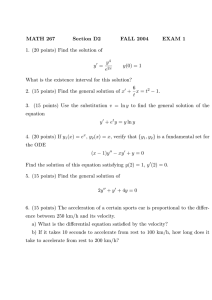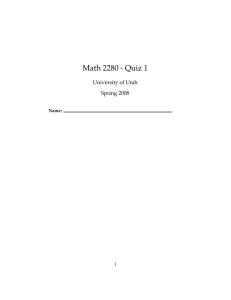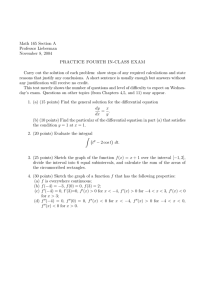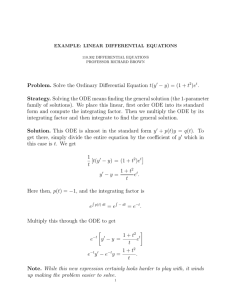§ 1.1 Definitions and Terminology
advertisement
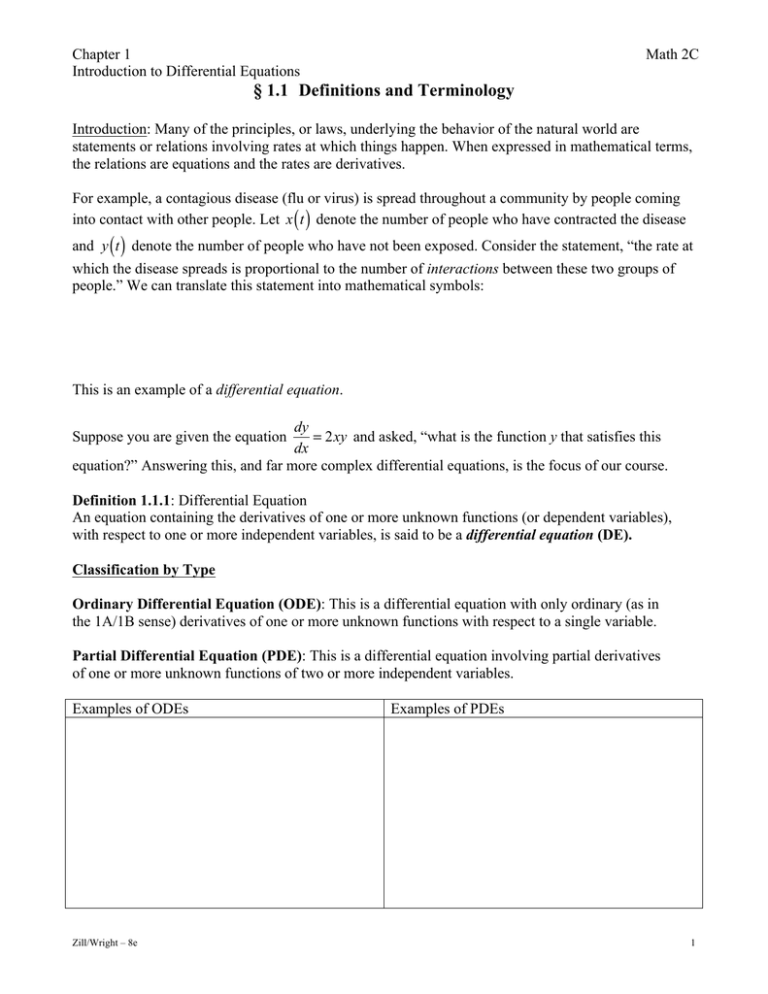
Chapter 1 Introduction to Differential Equations Math 2C § 1.1 Definitions and Terminology Introduction: Many of the principles, or laws, underlying the behavior of the natural world are statements or relations involving rates at which things happen. When expressed in mathematical terms, the relations are equations and the rates are derivatives. For example, a contagious disease (flu or virus) is spread throughout a community by people coming into contact with other people. Let x ( t ) denote the number of people who have contracted the disease and y ( t ) denote the number of people who have not been exposed. Consider the statement, “the rate at which the disease spreads is proportional to the number of interactions between these two groups of people.” We can translate this statement into mathematical symbols: This is an example of a differential equation. dy = 2xy and asked, “what is the function y that satisfies this dx equation?” Answering this, and far more complex differential equations, is the focus of our course. Suppose you are given the equation Definition 1.1.1: Differential Equation An equation containing the derivatives of one or more unknown functions (or dependent variables), with respect to one or more independent variables, is said to be a differential equation (DE). Classification by Type Ordinary Differential Equation (ODE): This is a differential equation with only ordinary (as in the 1A/1B sense) derivatives of one or more unknown functions with respect to a single variable. Partial Differential Equation (PDE): This is a differential equation involving partial derivatives of one or more unknown functions of two or more independent variables. Examples of ODEs Zill/Wright – 8e Examples of PDEs 1 Notation Leibniz notation: This has an advantage over the prime notation in that it clearly displays both the dependent and independent variables. Prime notion: This notation is more compact but it loses the dependent variable. So we have to be careful and always keep track of who we are “taking derivatives with respect to.” Newton’s dot notation: This is sometimes used to denote derivatives with respect to time t. d2y = y′′ = y dt 2 dy = y′ = y dt d3y = y′′′ = y dt 3 Classification by Order The order of a differential equation is the order of the highest derivative in the equation. For example: 4 d 3 y ⎛ dy ⎞ x 3 − ⎜ ⎟ + y = sin x is a ________ - order ODE. dx ⎝ dx ⎠ Normal Form: Consider the ODE d2y dy + 5 − 8y = e2t . This equation is equivalent to 2 dt dt d2y dy + 5 − 8y − e2t = 0 or y′′ + 5y − 8y − e2t = 0 . We can think of the LHS as a function of 2 dt dt the 4 variables t, y, y′ and y ′′ . In general, we can write any nth-order ODE in the form ( ) F x, y, y′,..., y ( n) = 0 . (F is a function of ________ variables.) We assume now that we can solve for y ( n) uniquely in terms of the remaining ________ variables. The differential equation becomes (where f is a real-valued continuous function). We call this form the normal form. Example: Write each equation in normal form. (Note the order of each equation.) a) xy ′ + 8y = x 5 Zill/Wright – 8e b) y′′ + 2 y′ − xy = 0 2 First-order ODEs are occasionally written in differential form M ( x, y ) dx + N ( x, y ) dy = 0 . For example, consider 3x 2 y′ + e2 x y = 5x Classification by Linearity ( ) An nth order ODE F x, y, y′,..., y ( n) = 0 is said to be linear if F is linear in y, y′,..., y ( n) . For example: Generally, we write the linear nth-order ordinary differential equation as: an (x) dny d n−1 y dy + a (x) + ...+ a1 (x) + a0 (x) y = g(x) n−1 n n−1 dx dx dx or an (x) y ( n) + an−1 (x) y ( n−1) + ...+ a1 (x) y ′ + a0 (x) y = g(x) We recognize the characteristic properties of a linear ODE: 1. The function y and all its derivatives y ′, y ′′,..., y ( n) are all to the first power. There are no products of the function y. 2. The coefficients an (x),an−1 (x),...,a1 (x),a0 (x) are functions of the one independent variable x. First-order linear ODE (in general): Second-order linear ODE (in general): Example: Determine whether each equation is linear or non-linear. State its order. 7 ⎛ dt ⎞ d 3t a) cost 3 + 4 ⎜ ⎟ + t = u 2 ⎝ du ⎠ du Zill/Wright – 8e b) cosu d 3t dt + 4 + t = u2 3 du du 3 Solutions Definition 1.1.2: Solution of an ODE Any function φ , defined on an interval I and possessing at least n derivatives that are continuous on I, which when substituted into an nth-order ODE reduces the equation to an identity, is said to be a solution of the equation on the interval. Note: 1. Sometimes we will denote the solution y(x) dy dy 2. Given y = e 5x , then = __________ . Written another way, = __________ . Thus, the dx dx dy solution to the linear ODE = 5y is __________ . dx 3. The interval I referred to in 1.1.2 is sometimes called the interval of definition, the interval of existence, the interval of validity, or the domain of the solution. It can be of the form ( a,b) , ⎡⎣ a,b⎤⎦ ,( a,∞ ) , etc. (It is a portion of the real number line!) It is the part of the number line for which the solution function satisfies the DE. If you solve a DE, you must think about the interval of existence. Example: Verify the indicated function is a solution of the given DE on the interval ( −∞,∞ ) . a) 1 dy = xy 2 ; dx y= b) y′′ − 10 y′ + 25y = 0 ; Zill/Wright – 8e 1 4 x 16 y = xe5x 4 Note: Both equations in the previous example have the constant solution __________ . A solution of a DE that is identically 0 on an interval I is said to be a trivial solution. Solution Curve If we graph the solution φ of an ODE, we call this graph a solution curve. There may be a difference between the graph of the function φ and the solution curve φ . Because φ is a solution of a DE, it is differentiable and thus continuous. In other words, there may be a difference between the interval of definition for the solution to the ODE and the domain of the function φ . dy 1 (verify!). But y is not differentiable at = 2xy 2 is y = dx 4 − x2 x = −2 or x = 2 , and is discontinuous at x = −2 or x = 2 . A solution to a DE is a function that is defined on an interval I on which it is differentiable and satisfies the equation. Example: A solution to the ODE dy 1 on any interval I that does not contain x = −2 or x = 2. We = 2xy 2 is y = dx 4 − x2 will take I to be as large as possible. Thus we take I to be either ( −∞,−2 ) , ( −2,2 ) or ( 2,∞ ) . So a solution to Explicit and Implicit Solutions Recall from calculus implicitly and explicitly defined functions ( y = ( x 2 +1) 3 5x 2 + 2 versus xe y − 3ysin x = 1 ). A solution in which the dependent variable is expressed solely in terms of the independent variable and constants is said to be an explicit solution. All solutions from the previous two examples (including y = 0) were explicit solutions. Definition 1.1.3: Implicit Solution of an ODE A relation G ( x, y ) = 0 is said to be an implicit solution of an ordinary differential equation on an interval I, provided that there exists at least one function φ that satisfies the relation as well as the differential equation on I. Example: ( a) Verify that the relation −2x 2 y + y 2 = 1 is an implicit solution of the ODE 2xy + x 2 − y Zill/Wright – 8e = 0. ) dy dx 5 4 b) Find at least one explicit solution φ to the ODE Give an interval of definition I of each solution φ . 3 2 1 -3 -2 -1 0 1 2 -1 -2 Families of Solutions When and why in integral calculus do we encounter a constant of integration, often called c. Recall, this gave us a family of curves. Analogously, we will usually be encountering a constant or parameter c (or many of them) when solving ODEs. 1. When solving a first-order DE F ( x, y, y′ ) = 0 , we usually obtain a solution containing a single arbitrary constant or parameter c. If this is the case, the set of solutions G ( x, y,c ) = 0 is called a one-parameter family of solutions. 2. When solving an nth-order DE F x, y, y′,..., y ( n) = 0 , we seek an n-parameter family of solutions ( ) G ( x, y,c1 ,c2 ,...,cn ) = 0 . This means that a single DE can have an infinite number of solutions corresponding to different choices for the parameter(s) ci . 3. A solution to a DE that has no parameters is called a particular solution. Example: Consider the linear second-order differential equation d2y dy − 8 + 16 y = 0 . 2 dx dx a) Circle the correct choice. The (one/two)-parameter family y = c1e4 x + c2 xe4 x is an (explicit/implicit) solution to the ODE. (Verify!) b) A ____________________ is y = 2e4 x − 3xe4 x corresponding 0 to c1 = 2 and c2 = −3 . Graphed to the right are some particular solutions for various choices of ci . Zill/Wright – 8e 6 3 Singular Solution: Sometimes a DE has a solution that is not a member of a family of solutions of the equation. (In other words, no choice of c will produce this solution.) For example, we have seen that y = 1 1 4 dy x and y = 0 are solutions of = xy 2 . We will see in chapter 16 dx 2 1 ⎛1 ⎞ dy = xy 2 has the one-parameter family of solutions y = ⎜ x 2 + c⎟ . If c = 0 we get two that the DE dx ⎝4 ⎠ y= 1 4 x . Notice that no choice of c will produce the trivial (and now singular) solution y = 0. 16 Systems of Differential Equations A system of ordinary differential equations is two or more equations involving the derivatives of two or more unknown functions of a single independent variable. For example dx = f ( t, x, y ) dt dy = g ( t, x, y ) dt dx = −5x − y + et dt dy = 4x − 6 y dt are examples of first-order systems of ODEs, where x and y denote dependent variables and t denotes the independent variable. A solution of a system is a pair of differentiable functions x = φ1 ( t ) and y = φ2 ( t ) , defined on a common interval I, that satisfy each equation of the system on this interval. Zill/Wright – 8e 7
